Atari 8-bit computer peripherals
This article covers the peripherals available for Atari's 8-bit computer family, which includes the 400/800, XL, XE, and the XEGS.
Because the Atari 400/800 8-bit computers included an RF modulator, stringent FCC regulations limiting radio emissions applied. Consequently, the Atari 400/800 systems internal construction used large metal frames as Faraday cages to prevent emissions. This prevented the use of plug-in internal cards to add connections for peripherals.
To permit easy expansion, Atari developed the SIO (Serial Input/Output) bus. This bus daisy chains together all Atari peripherals into a single string—disk drives, printers, modems, RS-232 interfaces. Since only one kind of connector plug is used for all devices, the Atari computer was easy for novice users to expand. Devices on the bus have their own IDs and peripherals can deliver downloadable drivers to the computer during the boot process. However, the additional electronics in these "intelligent" peripherals made them cost more than the "dumb" devices used by other systems.
List of peripherals
Both the names and styling of Atari's 8-bit peripherals generally matched the current computer range at the time they were released. Thus, they can be divided into one of three groups- those corresponding to the 400/800 era (4xx/8xx), the XL era (10xx) and the XE era (beginning with 'X') respectively. (The XL-era naming reflected Atari's original intention to launch an "Atari 1000" line.)[1] These are superficial issues; the majority of peripherals listed here will work with any 8-bit Atari computer.
In addition to those listed below, Atari failed to release a large selection of machines and peripherals that were otherwise completed. (See the externally linked FAQ below for details.)
400/800 era (1979-1982)
- 410 Program Recorder - a tape drive, 600 bit/s on compact cassettes
- There exist several variants of the 410. Early models were larger due largely to a much larger speaker area at the back, and had square cornered buttons. Later versions were smaller and had buttons that were rounded off on the front.[2]
- The 410 used stereo with the data recorded on one track and the other track holding audio that could be fed through the 400 or 800's sound output (as demonstrated by the language courses). The tape could also be programmatically stopped and started, provided the 'Play' button was engaged.
- 810 Disk Drive - a 5¼" floppy disk drive, single-density single-sided, 90 KB
- Pre-1982 drives "have notoriously poor speed regulation", ANALOG Computing reported in 1983; unlike other companies, "ATARI did not begin incorporating a reliable separator into the 810 until early 1982".[3]
- 820 40-Column Printer - dot matrix on adding machine paper
- 822 Thermal Printer - 40-column thermal on slightly wider paper
- 825 80-Column Printer - dot matrix, used the Centronics interface so required an 850 (repackaged Centronics 737)
- 830 Acoustic Modem - a 300-baud modem, using an acoustic coupler, used RS-232 so required an 850 (relabelled Novation CAT)
- 835 Direct Connect Modem - a 300-baud modem, direct connect, basic Hayes compatible with SIO interface
- 850 Interface Module - included four RS-232 ports and one Centronics parallel port[4]
- CX30 Paddle Controllers - a set of 2 potentiometers attached to a single Atari joystick port. Originally released with the Atari VCS console.
- CX40 joystick - 8-directional 1-button joystick, originally released with the Atari VCS console. Bundled with some Atari 400/800 packages and also sold separately. Originally all-black, a version with a matching gray base was later bundled with the Atari XEGS.
- CX70 Light Pen - a light pen. Bundled with demonstration software on cassette
- CX85 Numerical Keypad - external keypad that plugs into the joystick ports.
Prototypes and vaporware
- 815 Dual Disk Drive - dual 5¼" floppy disks, double-density single-sided, 180 KB (only small number of prototypes produced)
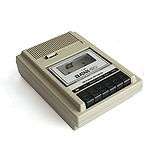 410 Tape Drive (later version)[2]
410 Tape Drive (later version)[2]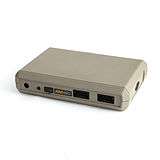 850 Expansion System
850 Expansion System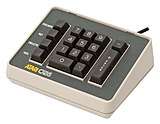 Atari CX85
Atari CX85
XL era (1982-1984)
- 1010 Program Recorder - a tape drive, a smaller replacement for the 410
- 1020 Color Printer - a 40-column plotter with 4 pens
- 1025 Printer - 80-column dot matrix (Okidata ML-80)
- 1027 Letter Quality Printer - 80-column letter quality that printed with a 5-wheels-on-a-drum system kept inked by a top-mounted roller (Mannesmann Tally Riteman LQ)
- 1029 Programmable Printer - 80-column lower-quality 7-pin dot matrix sold in Europe (Seikosha mechanism)
- 1030 Modem - 300 baud, direct connect with built in communications software.
- 1050 Dual-Density Disk Drive - 5¼" floppy disk, "enhanced density" format single-sided, 130 KB
- 1064 Memory Module - 64 KB memory expansion for 600XL
- CX75 Light Pen - a light pen. Bundled with the AtariGraphics drawing program on cartridge.
- CX77 Touch Tablet - a graphics tablet. Bundled with the AtariArtist drawing program on cartridge.[5][6][7]
- CX80 Trak-Ball Controller - a trackball, also contains a switch for joystick emulation
Prototypes and vaporware
- 1053 - a 5¼" floppy drive, looks like a 1050 but double-sided double-density, 360 KB
- 1055 - a 3½" floppy drive, single-side enhanced-density
- 1090 XL Expansion System - a case connected to the PBI port, with 5 slots intended for various expansion cards
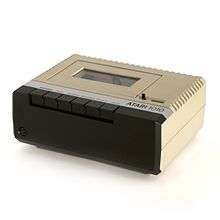 1010 Tape Drive
1010 Tape Drive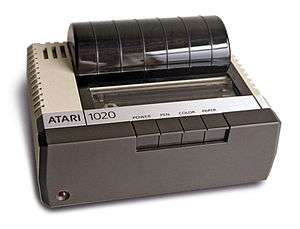 1020 4-color Plotter
1020 4-color Plotter 1027 Printer
1027 Printer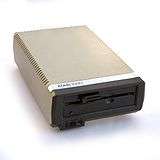 1050 Disk Drive
1050 Disk Drive
XE era (1985 onwards)
- XEP80 Interface Module - provides 80-column display and a Centronics parallel interface for a printer, controlled by NS405, an 8048 based chip. Attached via a joystick port controlled at 15625 baud horizontal video timing.[8]
- XC11 Program Recorder - a tape drive
- XC12 Program Recorder - a tape drive (small model like the 1010, sold worldwide). It was based on an earlier tape drive, Phonemark PM-4401A, not manufactured by Atari.[9] A number of similar models, not marketed by Atari were released, mainly in Eastern Europe and Latin America.[10] These included:
- XCA12 (same case as XC12)
- CA12 (same case as XC12)
- XL12 tape drive (an XC12 with minor changes)
- XF551 Disk Drive - 5¼" floppy disk, double-density double-sided, 360 KB
- XMM801 Dot-Matrix Graphics Printer - 80-column
- XDM121 Letter-Quality Daisy-Wheel Printer - 80-column
- XM301 Modem - 300 baud
- SX212 Modem - 1200 baud (also included RS-232 for use on Atari ST computers)
- XG-1 - a light gun, bundled with the Atari XEGS
Prototypes and vaporware
- XF351 - 3½" floppy drive (never released)
- XF521 - 5¼" floppy drive, 1050 compatible, XE style (never released)
- XC1411 - 14" composite monitor (never released)
- XM128 - 12" monochrome monitor (never made)
.jpg) CX40 joystick (XE grey version)
CX40 joystick (XE grey version) Atari XC12 program recorder
Atari XC12 program recorder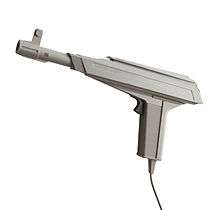
References
- The Atari Sweet-16 Project, atarimuseum.com. Article retrieved 2007-03-18.
- http://www.atarimuseum.de/a8_disk.htm
- Moriarty, Brian (July–August 1983). "Utility #6: Snail". ANALOG Computing. pp. 94–97.
- http://www.atarimuseum.com/computers/8BITS/400800/peripherals/Communications/850/index.htm
- Image Technology, By Don Leavitt, Popular Photography, Dec 1984, Page 140, ...the Okimate 10...will also work with Atari Artist,...
- Get the magic touch with the Atari Touch Table, Science Digest, Volume 92, 1984, Page 83, ...The ATARI Touch Tablet with Atari- Artist"' software cartridge turns your TV into a magic palette of 128 dazzling colors. The Touch Tablet works a little like an electronic slate. Hook it into any ATARI Computer and what you draw on the tablet ...
- RX8053 Atariartist, Atariartist came out in 1983 as a bundle package with the CX-77 Touch Tablet unit. The way it works is you start the program and use the pen to draw on the tablet and the images appear on the screen. This kind software would later be used in the early credit card signing devices in the early 90s.
- NS405: the heart of the XEP80
- Current, Michael D. (3 April 2014). "Atari 8-Bit Computers: Frequently Asked Questions" (TXT). 3.1.1) What are the Atari 410, 1010, XC11, & XC12 Program Recorders?. Retrieved 25 May 2014.
- Current, Michael D. (3 April 2014). "Atari 8-Bit Computers: Frequently Asked Questions" (TXT). 3.1.2) What other cassette recorders can I use with my Atari?. Retrieved 25 May 2014.